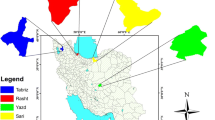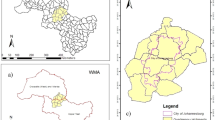Abstract
Rainwater harvesting has been widely used to alleviate urban water scarcity and waterlogging problems. In this study, a water balance model is developed to continuously simulate the long-term (57 to 65 years) stormwater capture efficiency of rainwater harvesting systems for three water demand scenarios at four cities across four climatic zones of China. The impacts of the “yield after spillage” (YAS) and “yield before spillage” (YBS) operating algorithms, climatic conditions, and storage and demand fractions on stormwater capture efficiency of rainwater harvesting systems are analyzed. The YAS algorithm, compared with the YBS, results in more conservative estimations of stormwater capture efficiency of rainwater harvesting systems with relatively small storage tanks (e.g., ≤50 m3). The difference between stormwater capture efficiency calculated using the YBS and YAS algorithms can be remedied by increasing storage capacity and reduced by decreasing water demand rates. Higher stormwater capture efficiency can be achieved for rainwater harvesting systems with higher storage and demand fractions and located in regions with less rainfall. However, the lager variations in annual rainfall in arid zones may lead to unstable stormwater management performance of rainwater harvesting systems. The impacts of storage and demand fractions on stormwater capture efficiency of rainwater harvesting systems are interactive and dependent on climatic conditions. Based on the relationships among storage capacity, contributing area, water demand, and stormwater capture efficiency of rainwater harvesting systems, easy-to-use equations are proposed for the hydrologic design of rainwater harvesting systems to meet specific stormwater control requirements at the four cities.





Similar content being viewed by others
References
Aladenola O, Cashman A, Brown D (2016) Impact of El Niño and climate change on rainwater harvesting in a Caribbean State. Water Resour Manag 30(10):3459–3347
Allen RG, Pereira LS, Raes D, Smith M (1998) Crop evapotranspiration- guidelines for computing crop water requirements. FAO Irrigation and Drainage paper56 Retrieved from http://www.fao.org/docrep/X0490E/X0490E00.htm
Almazroui M, Islam MN, Balkhair KS, Şen Z, Masood A (2017) Rainwater harvesting possibility under climate change: A basin-scale case study over western province of Saudi Arabia. Atmos Res 189:11–23
Amos CC, Rahman A, Gathenya JM (2016) Economic analysis and feasibility of rainwater harvesting systems in urban and peri-urban environments: a review of the global situation with a special focus on Australia and Kenya. Water 8(4):149
Basinger M, Montalto FA, Lall U (2010) A rainwater harvesting system reliability model based on nonparametric stochastic rainfall generator. J Hydrol 392(3–4):105–118
Burns MJ, Fletcher TD, Duncan HP, Hatt BE, Ladson AR, Walsh CJ (2015) The performance of rainwater tanks for stormwater retention and water supply at the household scale: an empirical study. Hydrol Process 29:152–160
Campisano A, Butler D, Ward S, Burns MJ, Friedler E, DeBusk K, Fisher-Jeffes LN, Ghisi E, Rahman A, Furumai H, Han M (2017) Urban rainwater harvesting systems: Research, implementation and future perspectives. Water Res 115:195–209
Campisano A, Modica C (2016) Rainwater harvesting as source control option to reduce roof runoff peaks to downstream drainage systems. J Hydroinf 18(1):23–32
Chou C, Chiang JCH, Lan C, Chung C, Liao Y, Lee C (2013) Increase in the range between wet and dry season precipitation. Nat Geosci 6:263–267
Crowley BJ (2005) A neighborhood level analysis of rainwater catchment in Portland, OR. Retrieved from http://www.harvesth2o.com/big_pipe_thesis.pdf
DB11/685 (2013) Code for Design of Stormwater Management and Harvest Engineering. Bureau of Quality and Technical Supervision of Beijing, Beijing (in Chinese)
DeBusk KM, Hunt WF, Wright JD (2013) Characterizing rainwater harvesting performance and demonstrating stormwater management benefits in the humid southeast USA. J Am Water Resour Assoc 49:1398–1411
Devkota J, Schlachter H, Apul D (2015) Life cycle based evaluation of harvested rainwater use in toilets and for irrigation. J Clean Prod 95:311–321
Fewkes A, Butler D (2000) Simulating the performance of rainwater collection and reuse systems using behavioural models. Build Serv Eng Res Technol 21(2):99–106
GhaffarianHoseini A, Tookey J, GhaffarianHoseini A, Yusoff SM, Hassan NB (2016) State of the art of rainwater harvesting systems towards promoting green built environments: a review. Desalinat Water Treat 57(1):95–104
Gilroy KL, McCuen RH (2009) Spatio-temporal effects of low impact development practices. J Hydrol 367:228–236
Guizani M (2016) Storm water harvesting in Saudi Arabia: a multipurpose water management alternative. Water Resour Manag 30(5):1819–1833
Guo Y, Baetz BW (2007) Sizing of rainwater storage units for green building applications. J Hydrol Eng 12:197–205
Haque MM, Rahman A, Samali B (2016) Evaluation of climate change impacts on rainwater harvesting. J Clean Prod 137:60–69
Imteaz MA, Ahsan A, Shanableh A (2013) Reliability analysis of rainwater tanks using daily water balance model: variations within a large city. Resour Conserv Recycl 77:37–43
Islam MM, Chou FNF, Kabir MR (2010) Acceptability of the rainwater harvesting system to the slum dwellers of Dhaka city. Water Sci Technol 61(6):1515–1523
Jenkins G (2007) Use of continuous simulation for the selection of an appropriate urban rainwater tank. Aust J Water Resour 11:231–246
Jing X, Zhang S, Zhang J, Wang Y, Wang Y (2017) Assessing efficiency and economic viability of rainwater harvesting systems for meeting non-potable water demands in four climatic zones of China. Resour Conserv Recycl 126:74–85
Kim J, Kim H, Demarie F (2017) Facilitators and barriers of applying low impact development practices in urban development. Water Resour Manag 31(20):1–14
Liaw CH, Tsai Y (2004) Optimum storage volume of rooftop rain water harvesting systems for domestic use. J Am Water Resour As 40(4):901–912
Litofsky ALE, Jennings AA (2014) Evaluating rain barrel storm water management effectiveness across climatography zones of the United States. J Environ Eng 140:223–224
Londra PA, Theocharis AT, Baltas E, Tsihrintzis VA (2015) Optimal sizing of rainwater harvesting tanks for domestic use in Greece. Water Resour Manag 29(12):4357–4377
Mahmoud SH, Adamowski J, Alazba AA, Ei-Gindy AM (2016) Rainwater harvesting for the management of agricultural droughts in arid and semi-arid regions. Paddy Water Environ 14:231–246
Melville-Shreeve P, Ward S, Butler D (2016) Rainwater harvesting typologies for UK houses: a multi criteria analysis of system configurations. WaterSA 8(4):129
Mitchell VG (2007) How important is the selection of computational analysis method to the accuracy of rainwater tank behaviour modelling. Hydrol Process 21(21):2850–2861
Nnaji CC, Emenike PC, Tenebe IT (2017) An optimization approach for assessing the reliability of rainwater harvesting. Water Resour Manag 31(6):2011–2024
Okoye CO, Solyalı O, Akıntuğ B (2015) Optimal sizing of storage tanks in domestic rainwater harvesting systems: a linear programming approach. Resour Conserv Recycl 104:131–140
Palla A, Gnecco I, La BP (2017) The impact of domestic rainwater harvesting systems in storm water runoff mitigation at the urban block scale. J Environ Manag 191:297–305
Palla A, Gnecco I, Lanza LG, Barbera PL (2012) Performance analysis of domestic rainwater harvesting systems under various European climate zones. Resour Conserv Recycl 62(4):71–80
Pelak N, Porporato A (2016) Sizing a rainwater harvesting cistern by minimizing costs. J Hydrol 541:1340–1347
Sample DJ, Liu J (2014) Optimizing rainwater harvesting systems for the dual purposes of water supply and runoff capture. J Clean Prod 75:174–194
Silva CM, Sousa V, Carvalho NV (2015) Evaluation of rainwater harvesting in Portugal: application to single-family residences. Resour Conserv Recycl 94:21–34
Steffen J, Jensen M, Pomeroy CA, Burian SJ (2013) Water supply and stormwater management benefits of residential rainwater harvesting in U.S. cities. J Am Water Resour As 49:810–824
Vaes G, Berlamont J (2001) The effect of rainwater storage tanks on design storms. Urban Water J 3:303–307
Wallace CD, Bailey RT, Arabi M (2015) Rainwater catchment system design using simulated future climate data. J Hydrol 529(3):1798–1809
Walsh TC, Pomeroy CA, Burian SJ (2014) Hydrologic modeling analysis of a passive, residential rainwater harvesting program in an urbanized, semi-arid watershed. J Hydrol 508(2):240–253
Zhang S, Guo Y (2013a) An analytical probabilistic model for evaluating the hydrologic performance of green roofs. J Hydrol Eng 18(1):19–28
Zhang S, Guo Y (2013b) Explicit equation for estimating the stormwater capture efficiency of rain gardens. J Hydrol Eng 18:1739–1748
Zhang S, Guo Y (2015) An analytical equation for evaluating the stormwater volume control performance of permeable pavement systems. J Irrig Drain Eng 141(4):06014004
Zhang X, Hu M (2014) Effectiveness of rainwater harvesting in runoff volume reduction in a planned industrial park, China. Water Resour Manag 28:671–682
Acknowledgements
This work has been supported by the Fundamental Research Funds for the Central Universities (NO. YX2015-18, 2016ZCQ06, and 2015ZCQ-SB-01) and the National Natural Science Foundation of China (NO. 51609004).
Author information
Authors and Affiliations
Corresponding author
Ethics declarations
Conflict of Interest
None.
Rights and permissions
About this article
Cite this article
Jing, X., Zhang, S., Zhang, J. et al. Analysis and Modelling of Stormwater Volume Control Performance of Rainwater Harvesting Systems in Four Climatic Zones of China. Water Resour Manage 32, 2649–2664 (2018). https://doi.org/10.1007/s11269-018-1950-4
Received:
Accepted:
Published:
Issue Date:
DOI: https://doi.org/10.1007/s11269-018-1950-4




